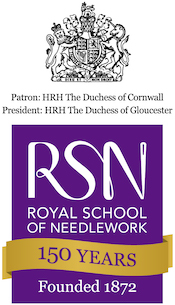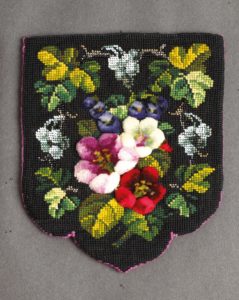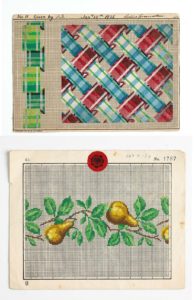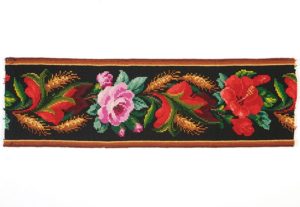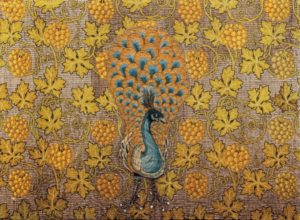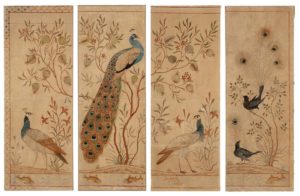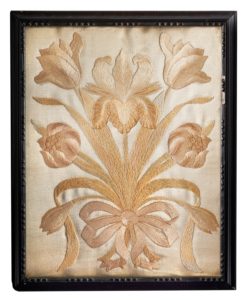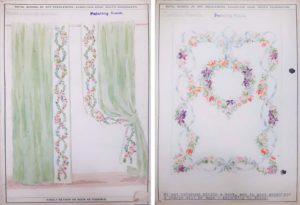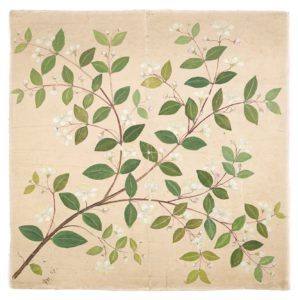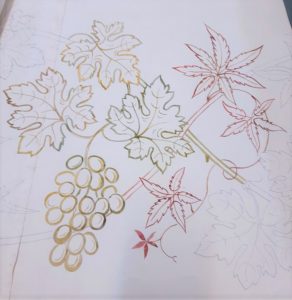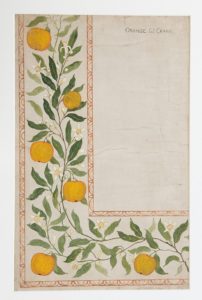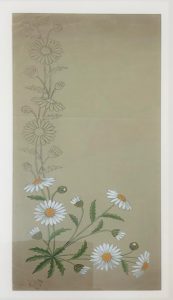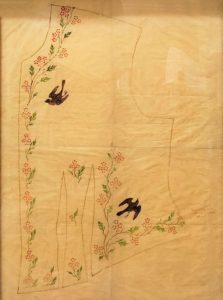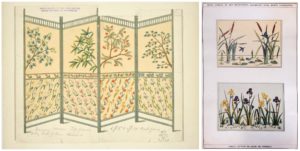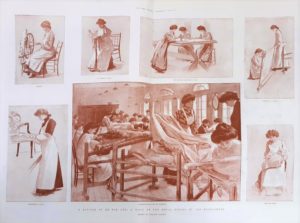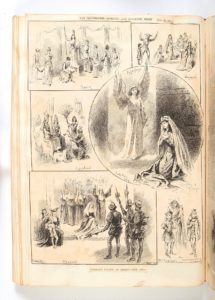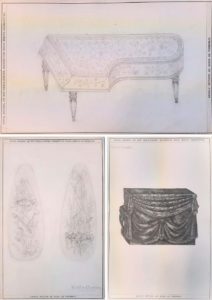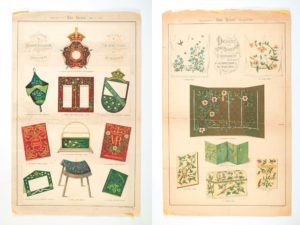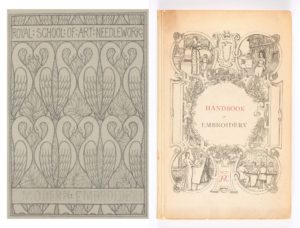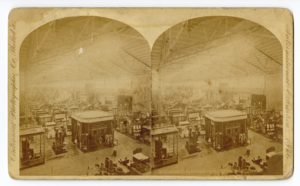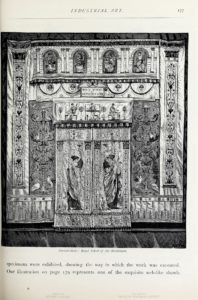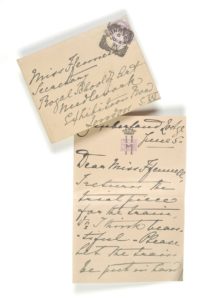Art Needlework
150 Years of the RSN: Virtual Exhibition
The early leaders were very keen on design and workers were frequently sent to the South Kensington Museum (now the Victoria and Albert) to copy and be inspired by old embroideries. Exhibitions of historic embroidery were common at its location on Exhibition Road. An Art Committee was established under artist Lord Frederic Leighton, artist Val Prinsep and architect George Frederick Bodley. They recommended that the School engage the leaders of the Arts and Crafts movement for designs, and so began the relationship between the RSN and William Morris, Edward Burne-Jones, Selwyn Image and especially Walter Crane, as well as others like George Aitchison, Fairfax Wade and Gertrude Jekyll who worked on interiors before she moved on to gardens.
The first results of these relationships were seen at the Philadelphia Centennial Exhibition in 1876,to which the RSN sent 160 pieces, influencing the designer Candace Wheeler. The School set up its own design and paint studio. Nellie Whichelo became head of the Paint Room and the RSN won a gold medal at the 1900 Paris Expo for her designs for hangings.
What distinguished art needlework was that it was mostly for interiors. The large pieces required a team of people to work on them to a common standard, so that the observer could not see individual hands.
While originally established to work commissions, the School was soon asked to teach. Private lessons began in the late 1870s and in 1880 the RSN produced the Handbook of Embroidery to pass on the skills of hand embroidery, but also to highlight art embroidery, with a series of designs featured at the end of the book.
Face Screens
19th century
Berlin wool work: crewel wool and beads on canvas, cord edging
Maker Unknown
Berlin wool work began in the early 19th century after a German printer realised he could print a grid and a pattern could be painted or printed on it for stitchers to follow. Much of this work could be done in just one stitch although here we have plush work and beads. A pair of face screens that would have been placed on table stands while two people conversed sitting either side of an open fire. The screens were to protect faces from the heat. When not in use they would have been placed on the mantelpiece. These would have been made by an amateur stitcher.
Designs for Berlin Wool Work
19th century
Printed cards, some numbered and dated Pear, Ribbons, borders
One shop on London’s Regent Street boasted that they had more than 16,000 patterns for Berlin wool work, such was its popularity across Europe, UK and the USA. These cards show some of the common features of the designs. Patterns could be flowers or geometrics in bright colours. Here there are ribbons for an all-over pattern, border designs and a flower design for a round footstool as well as the pear design which could have been used for something linear like a wide stool. These designs were invariably for practical, hard-wearing items such as bell pulls, stools or rugs.
Berlin Wool Work Border
19th century
Wool on canvas
Maker Unknown
This border fragment shows the particular style of flowers and stitches in Berlin wool work. Flowers are usually depicted as fully open, blowsy, within a breath of all the petals falling off. There is not the subtlety of 18th century flower sprigs. The popularity of this technique meant that all the other more detailed embroidery techniques were being lost.
Peacock and Vine Embroidery
1875-80
Embroidery wool and linen
Designed William Morris and Philip Webb
Made by the RSN
A version of Peacock and Vine worked by the RSN was sent to the Philadelphia Centennial Exhibition in 1876. Morris agreed to the RSN making up his designs for this show as it was a good way for his work to be seen in America. This is one of a number of Morris designs that the RSN made.
William Morris Gallery, London Borough of Waltham Forest
Angel Minstrel with Cymbals
c1885
Silk embroidery on cotton
Design based on a William Morris design for stained glass
Worked by Elizabeth (Bessie) Burden
Bessie Burden was the sister in law of William Morris. She was a very accomplished stitcher and she joined the RSN team to work on the pieces that went to Philadelphia, later returning to teach at the RSN. While there, the workers renamed her favourite stitch, Opus Plumarium as Burden stitch and this name was first published in the RSN Handbook of Embroidery in 1880. It has been known as Burden stitch since and can be seen in the stitching of the figure’s face.
William Morris Gallery, London Borough of Waltham Forest
Vain Jackdaw Screen
c1875
Painted canvas on wooden stretcher
Designs for four panel screen by Walter Crane
The RSN made several copies of this design in three and four-panel versions. A version certainly went to Philadelphia as it can be seen in the foreground of the main image of the RSN’s stand. This was one of several designs by Walter Crane that went to Philadelphia and his association with the RSN continued to the end of the nineteenth century.
Art Needlework Iris
1889
Wool and silk embroidery on satin
This piece was returned to the RSN in November 2021. It arrived with no details except on the back of the frame it bears a handwritten label – ‘On loan from Mr Swinburne Hanham Made by the Royal School of Art Needlework 1889’. The use of both silk and wool in the embroidery and the motif of the iris place this absolutely in the period of art needlework and the influence of Japonisme.
This piece has been welcomed into the RSN Collection, especially as it is probably the earliest embroidered work made by the School in the RSN Collection.
Design Cards from the RSN
c1872-1900
Paint and pencil on card
This is just a small selection of the extensive range of designs from the early days of the RSN. Art Embroidery was mostly focused on interiors but that might range from cushions and curtains to borders, hangings, screens and chair backs. Designers were both male and female including Gertrude Jekyll who is better known for her later work on gardens, and Madeline Wyndham (the Hon Mrs Percy Wyndham) who had a long association with the School including chairing the Art Committee.
The cards on which these designs are shown are also part of the history of the RSN. At the beginning the hand drawn cards would be sent to potential customers willingly, just printing on the cards ‘Kindly return as soon as possible’. Clearly, however, human nature was to be indecisive so the second iteration was a typed note to say that people had to return the cards within a week. Even this was not enough and the third iteration was to demand that the enquirer keep the cards for only ‘ONE CLEAR DAY’ before returning them in the condition and packaging as supplied. It is believed that people were copying the designs so they could make them up themselves rather than commissioning the RSN.
Designs from the RSN Archive
c1870s-1880s
Paint and pencil on card or waxed paper
Coloured and hand drawn designs by Mary Gemmell (left) who worked at the RSN until 1877, Edward Burne Jones, Mary Stuart-Wortley, George Aitchison and Walter Crane to show the variety of the designs many of which could be used in a range of pieces from small objects such as book covers to large hangings – Founder Lady Victoria Welby was very keen to see hand embroidery exhibited alongside fine art.
Vine Curtain Design
c1870s
Pencil and watercolour design on wallpaper
Like Miss Gemmell, Miss Cresswell was only at the RSN for a short time but in ‘Vine Curtain’ created a delightful design that is very much of its time. The painted part is one small section of the larger design. Miss Gemmell and Miss Cresswell left when the first financial crisis occurred in 1877 and cuts were needed.
Curtain Borders
c1870s-1880s
Paint and pencil on paper
Designed by Walter Crane
These are two of six curtain designs by Crane for the RSN. They are ‘Iris’ and ‘Orange’. Customers could choose their preferred design. Unfortunately, the workbooks from the early years are lost and so it is not possible to know to what extent these were selected.
Waistcoat Design by Walter Crane
c1880s
Pencil and paint on paper
Although art embroidery was predominantly focused on objects for interiors, the RSN also worked on embroidery for items of clothing, including for Queen Victoria in 1877. We assume this waistcoat design was used as it would have been a special commission, but the RSN has no other details about the making.
Influence of Japonisme
c1875-1880s
Paint and pencil on card
The iris and reed designs and especially the four-panel screen show the influence of Japonisme on the RSN. Japanese prints started to make their way to Europe from the opening up of Japan in the mid-1850s and were a huge influence on western artists and designers of the late 19th century.
The screen also shows two additional details of note – the size of the screen and also that the design is after 1875, because it has, bottom right, the intertwined VR with the crown above. This symbol for Victoria Regina was used by the RSN after the Queen became the RSN’s Patron in 1875. It also appeared on woven labels which were still being used in to the 1930s.
The RSN at Work
11 December 1904
Photo article in The Graphic magazine
Princess Helena was very aware of the power of the press and was keen to attract journalists to write about the RSN to attract more custom. This double page spread is from 1904 shortly after the RSN moved into its new purpose-built building in 1903. It shows the workers in the well-lit workroom, large windows and electric light as well as some of the activities of the school.
Tableaux Vivants Fundraiser
26 May 1892
Newspaper cutting
The RSN was always a non-profit organisation and needed to raise funds for new initiatives. One of the popular entertainments of the 1890s were tableaux vivants. In these, people would dress up to convey a scene, there would be very little action and usually few words, the audience would appreciate the set and the costumes and clap and then the curtains would close. The preparation for the next scene took so long that there was a musical interlude between each scene. This scrapbook features press coverage, illustrations of the scenes, drawings of some of the costumes. Press coverage was extensive, the equivalent of a feature in Tatler or Hello today.
Musical Instrument Covers
c1880s
Pencil on card design
The RSN could make embroidered covers and accessories for almost anything, as can be seen from these design cards giving options for embroidered violin cases and piano covers, whether upright or piano forte. There are no records as to how many of these the workers made. These are probably the most Victorian of objects, embracing their penchant for covering everything.
Supplement to The Queen Magazine
1880s
Colour magazine insert
The Queen was a new magazine in the 1880s and was the one place that the RSN seems to have placed paid adverts in the regular supplement to the magazine. These pages were in colour, which was not common at the time and featured a wide range of what the RSN could offer. At one end were large-scale items such as screens comprising 3-5 panels, while they also promoted small items including bellows covers, letter holders, book and timetable covers.
Handbook of Embroidery
1880
Printed books
In 1880 the RSN responded to requests for a book on embroidery techniques. However, it was not without its controversy. It was written by Letitia Higgin the RSN Secretary. On learning this Lady Marian Alford insisted on editing it. Miss Higgin’s name does not appear on the cover. More curiously, when printed there were two covers, one with swans, designed by Selwyn Image and one featuring women as mother, home-maker, artist and embroiderer. It was said that the ‘women’ cover was for the workroom staff. This cannot be verified but it is certainly rarer than the Image version. The full story of what happened after publication can be found in the facsimile edition of the RSN Handbook of embroidery available from the RSN shop online.
Image of the RSN Stand at the Philadelphia Centennial Exhibition
Digital copy of image
Paper
More than 3,000 images were taken of the Philadelphia Centennial Exhibition of 1876. The RSN’s stand appears on just a couple of these and the main image is this one. The RSN stand can be seen as something of a tent structure with works around the outside and, on the left, an entrance way into the inside. More than 160 pieces were sent but even with a space this large it is likely many were not exhibited.
Image courtesy of the Library Company of Philadelphia
Image of the Walter Crane-designed Hangings for Philadelphia
Digital copy of image
Paper
This was the major set of work sent to Philadelphia designed by Walter Crane. This introduced art embroidery to the USA and especially designer Candace Wheeler The RSN does not know where any of these pieces are today but we still hold the designs for Salve and Vale and there is a five-panel screen of the grotesque panels in the V&A. This image is from a line drawing which featured in books about the exhibition.
Only a small number of people, comparatively, could attend the exhibition so illustrated books were produced to be sold more widely. For a small organisation the RSN caught the imagination and many RSN objects were illustrated in these books.
Letter from Princess Helena
June 1891
Ink on paper
In the early days of the RSN the principal form of correspondence was by post, even for the smallest of notes which today might be a text. Some of the correspondence from Princess Helena is just about attending a meeting. In this case, it is more substantial. Her youngest daughter Marie Louise was getting married, and Princess Helena had commissioned a Court Train for her daughter for her to use when at Court with her new husband. Here she is confirming the commission.
